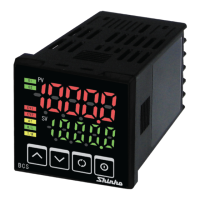
Do you have a question about the Shinko BCS2R Series and is the answer not in the manual?
| Brand | Shinko |
|---|---|
| Model | BCS2R Series |
| Category | Controller |
| Language | English |
Defines safety warnings and cautions for proper usage.
Key rules for safe operation, handling, environment, and specific cautions.
Warning about illegal export and use in weapons.
Details the model designation and its configurable options.
Explains how to interpret the model label attached to the unit.
Indicates the process variable (PV) and desired value (SV).
Explains the function of RST, EXC, A1, A2, AT, and T/R indicators.
Describes the function of UP, DOWN, MODE, and RESET keys.
Notice regarding connection and setting order before operation.
Specifies environmental conditions and site requirements for installation.
Provides dimensional drawings and required panel cutout for installation.
Cautions for mounting to the panel, including torque and gasket use.
Critical warning about turning off power before wiring.
Explains terminals, wiring practices, external components, and interference.
Specifies solderless terminal type and tightening torque for wiring.
Outlines the step-by-step procedure for setting input type, alarms, and SV.
Describes the main display modes and how to navigate them.
Details how to enter and use main and sub setting modes for parameters.
Selects input type, unit, and sets scaling high/low limits.
Sets PV filter constant and decimal point display for DC inputs.
Configures alarm types, action modes (Energized/De-energized), hysteresis, and delay times.
Selects control modes, hysteresis, and auto/manual start.
How to switch displayed items in PV/SV Display Mode.
How the PV/SV displays show maximum or minimum values.
Setting the desired value (SV) for the controller.
Setting the action point for A1 and A2 outputs.
Locks set values and adjusts input based on sensor correction.
Configures communication protocol, speed, parity, stop bits, and instrument number.
Selects input type, unit, and sets scaling high/low limits.
Sets PV filter constant and decimal point display for DC input.
Configures A1 and A2 alarm types and action modes.
Sets hysteresis and delay time for A1 and A2 alarms.
Selects limit control action and sets OUT1 hysteresis.
Sets start mode and unit for EXCEEDED indicator duration.
Adjusts input value based on sensor correction for accuracy.
Explains output behavior based on Energized/De-energized settings.
Illustrates high limit alarm logic for Energized and De-energized states.
Procedure to turn on power and observe initial indications.
Instruction to input set values referencing the settings section.
Final step to turn on load circuit power to start control.
Explains high limit control action with indicators and outputs.
Explains low limit control action with indicators and outputs.
Details auto and manual limit control modes and their conditions.
Illustrates various alarm actions (High limit, Low limit, etc.) and their output behavior.
Lists standard specs for mounting, display, accuracy, and input types.
Details specifications for OUT1, A1 outputs, and control actions.
Covers insulation, supply voltage, power consumption, and ambient conditions.
Details weight, external dimensions, material, and color.
Explains indication and control range behavior for thermocouple/RTD inputs.
Explains DC input behavior, range, and disconnection indications.
Describes behavior for burnout and CPU self-diagnosis.
Covers cold junction compensation and power failure data backup.
Explains peak/bottom value hold and indicator duration settings.
Lists included and separately sold accessories.
Details specifications for the A2 output option.
Configures communication parameters for C5 option.
Explains the function of the external reset input option.
Lists common PV display indications and their causes/solutions.
Guides on checking input signal wires, sensor polarity, and wiring.
Addresses issues related to AC leaks, sensors, and external interference.
Troubleshooting PV display stuck on scaling low limit or showing errors.
Addresses issues with key operations and control functions like temperature rise.
